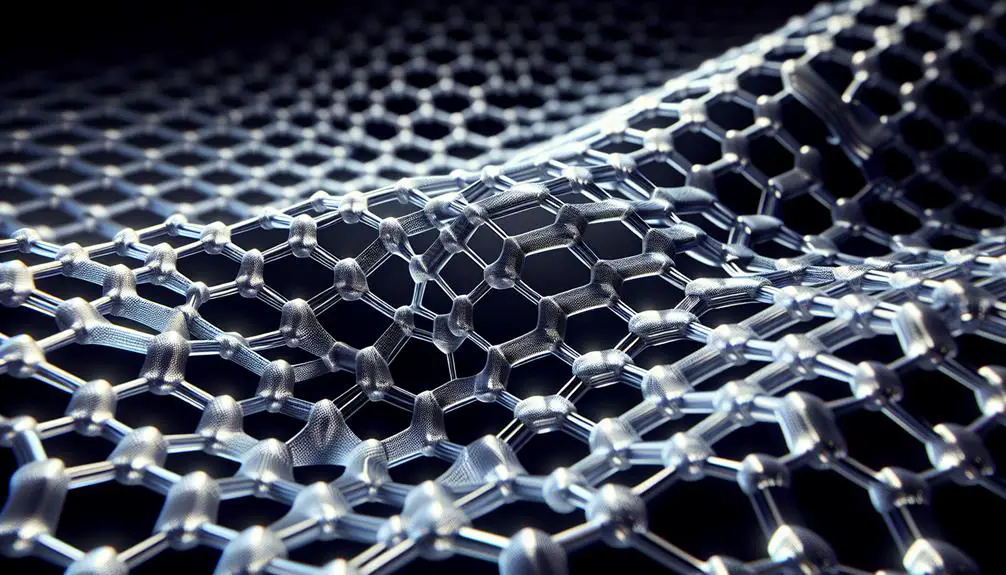You might be surprised to learn how graphene-enhanced fabrics are transforming the textile industry. By integrating graphene, a material known for its exceptional conductivity and strength, into fabrics, manufacturers are creating textiles that are not only more durable but also offer unique functionalities like temperature regulation and health monitoring. This innovation doesn't just promise enhanced performance but also offers environmentally sustainable solutions. Curious about how these advanced materials are reshaping sportswear, everyday clothing, and even medical wearables? There's much more to uncover about the future of textiles and the role graphene plays in this evolution.
Table of Contents
Key Takeaways
- Graphene-enhanced fabrics offer exceptional durability, flexibility, and conductivity, revolutionizing multiple textile applications.
- These fabrics provide superior temperature regulation and moisture-wicking properties, ensuring comfort in various weather conditions.
- Integration of biometric sensors in graphene textiles enables real-time health monitoring and remote data sharing with medical professionals.
- Graphene-enhanced fabrics deliver antibacterial properties, UV protection, and seamless integration of smart technologies.
- Their increased durability and sustainability reduce waste and lower the environmental impact compared to traditional fabrics.
Understanding Graphene
Graphene is a single layer of carbon atoms arranged in a two-dimensional honeycomb lattice. It's the thinnest material known but also incredibly strong, making it a fascinating subject for applications in various fields.
One of graphene's standout features is its exceptional electrical conductivity, which surpasses that of copper. This property opens up a multitude of graphene applications, especially in electronics.
You'll find graphene incorporated into high-performance batteries, enhancing their charge speed and capacity. Due to its remarkable conductivity, it's also used in the development of flexible electronics, allowing devices to bend and stretch without losing functionality. Imagine a smartphone screen that's virtually unbreakable yet fully flexible.
In addition to electronics, graphene's thermal conductivity makes it ideal for cooling systems in advanced tech devices. It efficiently dissipates heat, thereby improving the performance and longevity of gadgets.
This material is also making waves in the world of sensors. Graphene-based sensors are incredibly sensitive and can detect substances at very low concentrations, making them invaluable in medical diagnostics and environmental monitoring.
Understanding graphene's unique properties and broad range of applications will empower you to harness its potential in your projects.
Properties of Graphene-Enhanced Fabrics
You'll be amazed by how graphene-enhanced fabrics combine durability, flexibility, and conductivity to revolutionize the textile industry. Imagine wearing a fabric that's not only incredibly strong but also remarkably flexible, adapting to your every move. These fabrics offer a perfect balance of resilience and comfort, making sure you enjoy both long-lasting wear and ease of movement.
Graphene's innate antibacterial properties make these fabrics ideal for healthcare and activewear applications. By integrating graphene, you create textiles that resist bacterial growth, keeping your garments fresher for extended periods. Additionally, graphene's exceptional UV protection shields you from harmful sun rays, enhancing the fabric's practicality for outdoor activities.
Despite their robustness, graphene-enhanced fabrics maintain a lightweight design, making them perfect for high-performance sportswear and everyday clothing. Their flexibility ensures they can withstand the rigors of daily use without compromising on comfort or functionality.
Moreover, the conductivity of graphene opens up new possibilities for integrating smart technologies into textiles. While we'll explore further into applications like health monitoring wearables later, it's essential to understand that graphene's conductivity is a game-changer. It allows you to explore innovative designs that seamlessly blend technology with fashion.
Health Monitoring Wearables
How can graphene-enhanced fabrics transform health monitoring wearables into seamless, high-tech garments? Imagine a world where your clothing not only looks stylish but also monitors your health in real-time. With graphene-enhanced fabrics, this vision becomes a reality.
These smart textiles seamlessly integrate biometric sensors, allowing for sophisticated remote monitoring of essential signs, such as heart rate, blood pressure, and even glucose levels. Incorporating graphene into fabrics enhances their conductivity, making it possible to embed high-performance biometric sensors directly into the material. This eliminates the need for bulky external devices, resulting in lightweight and comfortable wearables.
You can effortlessly track your fitness metrics, from daily step counts to advanced physiological data, all through your clothing. What sets graphene-enhanced fabrics apart is their ability to provide continuous, real-time data, essential for both fitness tracking and long-term health monitoring.
Whether you're an athlete aiming to optimize performance or someone managing a chronic condition, these smart textiles offer unparalleled convenience and accuracy. Remote monitoring capabilities mean you can share your health data with medical professionals without frequent visits, enhancing both personal and professional healthcare outcomes.
Embrace the future where your clothes do more than just cover you—they care for you.
Temperature Regulation
With graphene-enhanced fabrics, you'll experience superior temperature regulation thanks to their excellent thermal conductivity.
These fabrics also wick moisture efficiently, keeping you dry and comfortable.
Whether it's hot or cold outside, their seasonal versatility guarantees peak comfort year-round.
Thermal Conductivity Benefits
By incorporating graphene into fabrics, you can achieve superior temperature regulation due to its excellent thermal conductivity. Graphene's unique structure allows it to conduct heat efficiently, ensuring that your garments respond dynamically to your body's needs. This leads to enhanced comfort and performance, whether you're in a hot or cold environment.
Here are some key benefits of graphene's thermal conductivity in fabrics:
- Enhanced Thermal Regulation: Graphene's ability to evenly distribute heat helps maintain an efficient temperature, preventing overheating or excessive cooling. This property is particularly beneficial for activewear and outdoor clothing.
- Energy Efficiency: Due to its thermal regulation properties, graphene-enhanced fabrics can minimize the need for additional heating or cooling, contributing to sustainability benefits. You'll find yourself less dependent on external temperature control, reducing energy consumption.
- Durability: Graphene isn't only thermally conductive but also incredibly strong. This means your graphene-infused garments will last longer, maintaining their temperature-regulating properties over extended use.
- Reduced Environmental Impact: The durability and energy efficiency of graphene-enhanced fabrics lead to a smaller environmental footprint. By investing in these advanced textiles, you're supporting sustainable practices in the textile industry.
Graphene-enhanced fabrics offer a blend of comfort, performance, and sustainability, making them a smart choice for anyone seeking mastery over their clothing choices.
Moisture-Wicking Properties
Beyond thermal regulation, graphene's integration into fabrics excels at moisture-wicking, ensuring you stay dry and comfortable.
Imagine wearing a garment that not only keeps you warm or cool but also efficiently manages perspiration. Graphene-enhanced fabric technology achieves superior moisture-wicking performance by rapidly drawing sweat away from your skin and dispersing it across the fabric's surface. This innovation makes these textiles highly effective at maintaining ideal body temperature and comfort, even during intense physical activities.
Graphene's unique lattice structure provides a high surface area that boosts the fabric's ability to handle moisture. The result? Fabrics that dry faster and feel lighter, enhancing your overall experience.
By incorporating graphene, manufacturers can create high-performance clothing that's not just functional but also sustainable. The durability of graphene means your garments will last longer, reducing the need for frequent replacements and thereby minimizing environmental impact.
Moreover, the sustainability of graphene-enhanced fabrics is underscored by their ability to reduce reliance on traditional moisture-wicking treatments, which often involve harmful chemicals. This makes graphene a game-changer in the quest for eco-friendly performance wear.
Embrace the future of fabric technology with graphene-enhanced garments that prioritize both innovation and sustainability.
Seasonal Versatility
Graphene-enhanced fabrics adapt seamlessly to different seasons, guaranteeing you stay comfortable whether it's hot or cold. This remarkable fabric innovation leverages the unique properties of graphene, offering unmatched adaptability and sustainability.
Imagine never having to switch out your wardrobe with the changing seasons. Graphene textiles excel in temperature regulation, keeping you warm in winter and cool in summer. These fabrics achieve this through their exceptional thermal conductivity, which efficiently distributes heat to maintain an ideal temperature.
Let's break down how graphene-enhanced fabrics work:
- Thermal Conductivity: Graphene's high thermal conductivity ensures your body heat is evenly distributed, preventing overheating or excessive cooling.
- Breathability: These fabrics allow for excellent air circulation, reducing sweat and moisture buildup even during the hottest days.
- Lightweight Insulation: Despite being incredibly thin and lightweight, graphene textiles provide strong insulation, making them perfect for layering in colder months.
- Durability: The strength of graphene ensures your garments last longer, contributing to sustainability by reducing the need for frequent replacements.
Incorporating graphene into textiles isn't just an innovation; it's a revolution in adaptability and sustainability. By embracing these advanced materials, you elevate your comfort and contribute to a more sustainable future.
Enhanced Durability
With graphene's integration, fabrics experience a remarkable increase in durability. Imagine not having to worry about wear and tear as much, thanks to graphene's extraordinary properties. During durability testing, graphene-enhanced fabrics consistently outperform their traditional counterparts. These fabrics don't just last longer; they maintain their quality and appearance through countless cycles of use and washing.
You'll find that fabric longevity is taken to a new level. Graphene's unique molecular structure provides an exceptional barrier against abrasions, cuts, and even UV radiation. This means your graphene-infused clothing will withstand the rigors of daily life, whether you're hiking through rough terrain or simply going about your routine.
Moreover, the enhanced durability doesn't compromise comfort or flexibility. The incorporation of graphene into textiles guarantees that the fabric remains lightweight and breathable while offering superior strength. You're not just investing in clothes; you're investing in a reliable, long-lasting wardrobe.
Environmental Impact
You'll be pleased to know that graphene-enhanced fabrics notably reduce the carbon footprint by requiring less energy in production.
These fabrics also promote sustainable material sourcing by incorporating eco-friendly practices.
Plus, they help lower waste through increased durability and longer lifespan.
Reduced Carbon Footprint
Incorporating graphene into fabrics diminishes their environmental footprint by reducing the need for resource-intensive materials. When you use graphene, you enable sustainable manufacturing and adopt eco-friendly practices that cut down on waste and emissions.
Here's how graphene-enhanced fabrics help reduce the carbon footprint:
- Lower Energy Consumption: Traditional textile production consumes significant energy. Graphene's superior properties, such as increased strength and conductivity, reduce the need for high-energy processes.
- Enhanced Durability: Fabrics enhanced with graphene are more durable, extending their lifecycle. Longer-lasting textiles mean fewer replacements and less waste, translating to a reduced environmental burden.
- Recycling Efficiency: Graphene can be incorporated into recycling processes more efficiently than conventional materials, promoting a circular economy. This reduces the demand for new raw materials and minimizes landfill waste.
- Reduced Chemical Use: The use of graphene can decrease the need for harmful chemicals and dyes in textile manufacturing. This not only reduces water pollution but also promotes healthier ecosystems.
Sustainable Material Sourcing
Graphene's integration into fabrics underscores the importance of sustainable material sourcing by utilizing fewer raw resources. By adopting graphene, you're not just enhancing textile performance; you're actively reducing the environmental burden associated with traditional fabric production.
The journey towards ethical production begins with choosing materials that require less energy and fewer chemicals, minimizing ecological footprints.
Incorporating graphene into your textile processes means embracing a circular economy. Unlike conventional materials that often lead to waste, graphene offers durability and longevity, aligning perfectly with the principles of sustainability. You're not only using fewer resources but also promoting a lifecycle where materials are continually repurposed and recycled.
You have the power to transform the textile industry by advocating for ethical production practices. Graphene-enhanced fabrics present an opportunity to shift away from resource-intensive manufacturing towards a model that values environmental stewardship.
The move towards sustainable material sourcing isn't just a trend; it's a necessity for a future where the textile industry thrives without compromising the planet. By integrating graphene, you contribute to a more sustainable world, demonstrating that innovation and responsibility can go hand in hand.
Waste Reduction Benefits
By opting for graphene-boosted fabrics, you notably reduce textile waste and its environmental impact. These innovative materials offer a range of eco-friendly solutions that align with sustainable practices. Here's how they make a difference:
- Durability: Graphene's strength notably extends the lifespan of fabrics. You won't need to replace items as frequently, which means less waste in landfills.
- Efficiency in Production: The production process for graphene-boosted textiles is more efficient, requiring fewer raw materials and generating less waste. This aligns perfectly with sustainable practices.
- Recycling Potential: Graphene-infused fabrics are easier to recycle. Their enhanced properties ensure that they can be repurposed without significant degradation, contributing to a circular economy.
- Reduced Chemical Use: Traditional textile manufacturing often involves harmful chemicals. Graphene-boosted fabrics require fewer chemicals, making the process more eco-friendly and reducing the environmental impact.
Market Trends
The market for graphene-enhanced fabrics is experiencing rapid growth, driven by increasing demand for advanced materials in various industries. You'll notice that consumer demand is soaring, especially in sectors like sportswear, military applications, and medical textiles. People are hungry for fabrics that offer superior durability, conductivity, and breathability, and graphene delivers on all fronts.
This surge in interest is also influencing pricing trends, making these high-performance fabrics more accessible as economies of scale come into play.
On a global scale, the industry is witnessing remarkable growth. North America and Europe are leading the charge, but Asia-Pacific is catching up quickly, thanks to robust manufacturing capabilities and increased R&D investments. Companies are racing to incorporate graphene into their textile lines, aiming to capture a slice of this burgeoning market.
This global market expansion is fueling industry growth and fostering collaborations between textile manufacturers and graphene suppliers.
You'll find that the competitive landscape is intensifying, with new entrants and established players vying for market share. This dynamic environment is pushing innovation boundaries, ensuring that graphene-enhanced fabrics will continue to evolve and meet the sophisticated demands of the modern consumer.
Future Prospects
Looking ahead, you'll see graphene-enhanced fabrics poised to revolutionize multiple industries with their unparalleled properties. The future prospects for these textiles are incredibly promising due to their superior strength, conductivity, and flexibility.
As market expansion continues, you'll witness these fabrics breaking into new sectors and applications, driven by ongoing technological advancements.
Consider these key areas for future growth:
- Wearable Technology: Graphene's conductivity and flexibility make it ideal for integrating sensors and electronics into clothing, enhancing health monitoring and connectivity.
- Smart Textiles: Expect fabrics that not only sense environmental changes but also respond to them, offering adaptive comfort and functionality tailored to individual needs.
- Sustainability: Graphene-enhanced fabrics will contribute to eco-friendly solutions by improving the durability and lifespan of textiles, thereby reducing waste and the need for frequent replacements.
- Industrial Applications: From construction to automotive industries, these fabrics will provide enhanced strength and resilience, opening up new possibilities for material innovation.
Frequently Asked Questions
How Do Graphene-Enhanced Fabrics Compare in Cost to Traditional Textiles?
When you compare the cost, graphene-enhanced fabrics are pricier than traditional textiles. However, the durability benefits justify the investment, offering longer-lasting wear and performance, making them a wise choice for those seeking quality.
Can Graphene-Enhanced Fabrics Be Used in High-Performance Sportswear?
Imagine wrapping yourself in a second skin. Yes, graphene-enhanced fabrics can be used in high-performance sportswear. They boost athletic performance, offer exceptional durability, and excel in moisture-wicking and breathability, making them a game-changer.
Are There Any Special Care Instructions for Washing Graphene-Enhanced Fabrics?
When washing graphene-enhanced fabrics, follow these washing tips: use cold water and mild detergent. To maintain fabric durability, avoid bleach. Cleaning methods should include gentle cycles. For maintenance guidelines, air-dry instead of using a dryer.
How Long Does the Graphene Enhancement Last in Fabrics After Repeated Use?
Think of it like the durability of Achilles' armor. With proper care, the performance-enhancing qualities of graphene can last for years, even with repeated use. Maintain them well, and they'll serve you impressively over time.
Can Graphene-Enhanced Fabrics Be Recycled or Repurposed Easily?
You can recycle graphene-enhanced fabrics using the standard recycling process. However, repurposing options might be limited due to the specialized material. Understanding graphene's properties will help you make informed decisions on recycling or repurposing.
- Kevlar Suppliers in Melbourne: Australia’s Manufacturing Hub - June 21, 2025
- Kevlar Suppliers in Pune: Business Insights and Recommendations - June 21, 2025
- Kevlar Suppliers in Kolkata: A Comparative Shopping Guide - June 21, 2025







